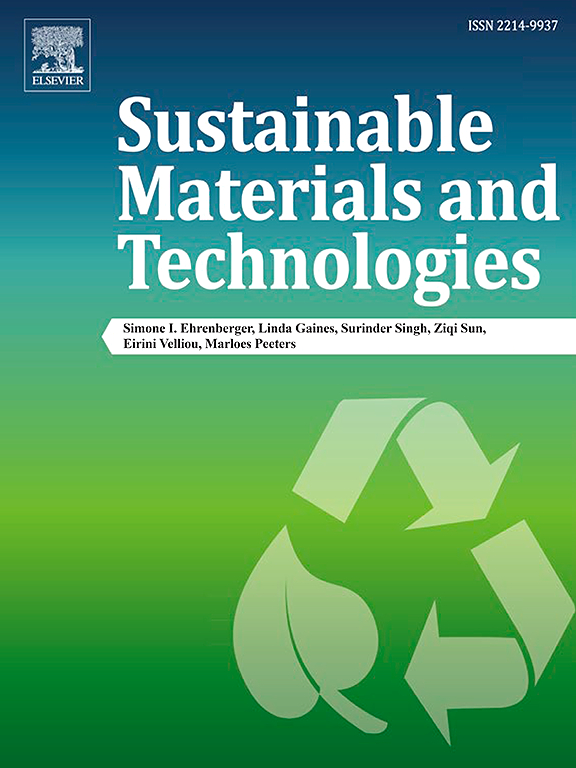柴油发动机废轮胎热解技术综述:技术、挑战和未来展望
IF 8.6
2区 工程技术
Q1 ENERGY & FUELS
引用次数: 0
摘要
废轮胎热解转化为解决废轮胎废弃物管理问题具有重要的潜力。本研究旨在批判性地分析废轮胎热解过程及其产物,特别是废轮胎热解油。研究的关键因素包括热解过程的类型、热物理性质、脱硫方法、反应器设计以及废轮胎热解油的性能、排放和燃烧特性。微波和真空热解被认为是高效的热解方法。在脱硫技术中,超声波氧化脱硫因其低操作要求和低成本效益而被证明是非常有效的。锥形喷淋床反应器是最有效的热解采油反应器设计。此外,响应面法作为一种优化热解过程参数的工具也得到了广泛的应用。较少的芳香族化学物质、较低的粘度和较高的十六烷值是轮胎热解作为柴油机替代燃料的有利特性。所有这些共同将轮胎裂解油定位为柴油的可行替代燃料。然而,热解过程的副产品——固体炭(回收的炭黑)、石油和天然气——由于工艺复杂性、经济挑战和环境问题而面临限制。随着工业增长和全球变暖,向可持续、经济和绿色废橡胶管理的转变被引用。循环经济模式为废旧轮胎的热解管理提供了环保、有效和可持续的替代方案。轮胎橡胶、回收/脱硫化和热固性/WTR系统等回收方法更环保,更具成本效益。废轮胎热解可以有效地实现制氢和碳纳米管。监督式机器学习也被用于预测热解过程的特征,尽管需要进一步集中努力来加强其应用。此外,物联网在废轮胎热解中的整合仍然有限,未来需要取得重大进展。本文章由计算机程序翻译,如有差异,请以英文原文为准。

A critical review of waste tire pyrolysis for diesel engines: Technologies, challenges, and future prospects
Conversion of waste tires through the pyrolysis process presents significant potential to tackle waste management problems of waste tires. This study aims to critically analyze the waste tire pyrolysis process and its products, with a particular focus on waste tire pyrolysis oil. Key factors examined include types of pyrolysis processes, thermo-physical properties, desulphurization methods, reactor designs, and the performance, emissions, and combustion characteristics of waste tire pyrolysis oil. Microwave and vacuum pyrolysis processes were identified as highly efficient methods. Among desulphurization techniques, ultra-sound oxidative desulphurization proved exceptionally effective due to its low operation requirements and cost efficiency. The conical spouted bed reactor emerged as the most efficient reactor design for pyrolysis oil production. Additionally, response surface methodology demonstrated promise as an optimization tool for refining pyrolysis process parameters. Less aromatic chemicals, less viscosity and high cetane number were found to be favorable characteristics for application of tire pyrolysis as alternative fuel for diesel engines. All these collectively position tire pyrolysis oil as a viable alternative fuel to diesel. However, the by-products of the pyrolysis process – solid char (recovered carbon black), oil, and gas – face limitations due to process complexity, economic challenges and environmental concerns. With industrial growth and global warming, a shift towards sustainable, economical, and green waste rubber management was cited. The circular economy model offers eco-friendly, effective, and sustainable alternatives to pyrolysis for waste tire management. Recycling methods like ground tire rubber, Reclaiming/Devulcanization, and thermosets/WTR systems are eco-friendlier and more cost-effective. Hydrogen production and carbon nanotubes can be efficiently achieved through waste tire pyrolysis. Supervised machine learning has also been employed to predict the characteristics of the pyrolysis process, though further focused efforts are needed to enhance its application. Additionally, the integration of the Internet of Things in waste tire pyrolysis remains limited and requires significant advancements in the future.
求助全文
通过发布文献求助,成功后即可免费获取论文全文。
去求助
来源期刊

Sustainable Materials and Technologies
Energy-Renewable Energy, Sustainability and the Environment
CiteScore
13.40
自引率
4.20%
发文量
158
审稿时长
45 days
期刊介绍:
Sustainable Materials and Technologies (SM&T), an international, cross-disciplinary, fully open access journal published by Elsevier, focuses on original full-length research articles and reviews. It covers applied or fundamental science of nano-, micro-, meso-, and macro-scale aspects of materials and technologies for sustainable development. SM&T gives special attention to contributions that bridge the knowledge gap between materials and system designs.
 求助内容:
求助内容: 应助结果提醒方式:
应助结果提醒方式:


